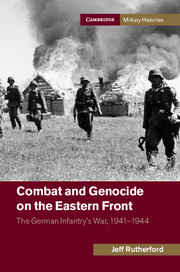Book contents
- Frontmatter
- Table of contents
- List of illustrations
- List of figures
- List of maps
- List of tables
- Acknowledgments
- Introduction
- 1 The Wehrmacht and German society
- 2 Preparations for war
- 3 “Attack with a ruthless offensive spirit and … a firestorm of destruction”
- 4 “Will the continuation of this attackbe worth it?”
- 5 “It is only a question of where, not if, civilians will starve”
- 6 The failure of Operation Barbarossa
- 7 The Soviet winter offensive, 1942
- 8 “The population … shouted out to the interpreter that one would rather be shot instead of being left to starve”
- 9 “From one mess to another”
- 10 “We need to fight to the end, so oder so”
- 11 A more rational occupation?
- 12 “As miserable representatives of themiserable twentieth century, we burnedall of the villages”
- Conclusion
- Bibliography
- Index
- References
1 - The Wehrmacht and German society
Published online by Cambridge University Press: 05 July 2014
- Frontmatter
- Table of contents
- List of illustrations
- List of figures
- List of maps
- List of tables
- Acknowledgments
- Introduction
- 1 The Wehrmacht and German society
- 2 Preparations for war
- 3 “Attack with a ruthless offensive spirit and … a firestorm of destruction”
- 4 “Will the continuation of this attackbe worth it?”
- 5 “It is only a question of where, not if, civilians will starve”
- 6 The failure of Operation Barbarossa
- 7 The Soviet winter offensive, 1942
- 8 “The population … shouted out to the interpreter that one would rather be shot instead of being left to starve”
- 9 “From one mess to another”
- 10 “We need to fight to the end, so oder so”
- 11 A more rational occupation?
- 12 “As miserable representatives of themiserable twentieth century, we burnedall of the villages”
- Conclusion
- Bibliography
- Index
- References
Summary
Nazi state and society
Perhaps the most important and vexing question regarding the Third Reich centers on the German population’s support for and identification with the regime and its objectives: in other words, how successful was the state in constructing a Volksgemeinschaft, one united behind the regime and committed to realizing its goal of a wide-ranging ethnic restructuring of central and eastern Europe? Such an issue is certainly important when attempting to gauge how and why the Wehrmacht waged a war of extermination against the Soviet state and society; unfortunately, it is also difficult to ascertain. Scholarship stretching back five decades has reached contradictory conclusions regarding the German population’s attitude towards the Nazi state. While an examination of this charged issue is neither feasible nor desirable in this study, some discussion of Nazi society is absolutely necessary to understanding the institution and its men who waged the Vernichtungskrieg against the Soviet Union.
The notion of a “violent society,” first formulated by Christian Gerlach, provides a solid starting point for understanding the relationship between Nazi state and society. Gerlach argues that within Nazi Germany, “a variety of policies and forms of mass violence were utilized against victim groups,” and that while many of the perpetrators saw themselves as “functionaries of the state,” this was a rather loosely defined group that included far more than just members of the SS-Police or state administrations. The most “stunning” find here, however, “is not the dominance of one specific group of those responsible, but just the diversity of backgrounds, experiences, education and age groups.”
- Type
- Chapter
- Information
- Combat and Genocide on the Eastern FrontThe German Infantry's War, 1941–1944, pp. 34 - 55Publisher: Cambridge University PressPrint publication year: 2014



